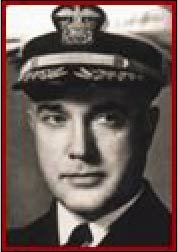INDIANAPOLIS TRAGEDY - Part 4
NAVY EXONERATES CAPTAIN OF THE USS INDIANAPOLIS
The story finally comes to an end. When the above headlines appeared in all the newspapers there were many who felt, and still feel that an injustice had been done and that McVay was guilty and had a fair trial. Others considered that he was absolutely not guilty of anything. As the years pass I am sure that none of these people will change their mind, so his guilt or innocence will remain a matter of personal opinion. This latest newspaper article will serve as the final word on the subject, and like the entire story this article too will become an extension to the controversy.
Captain Charles Butler McVay III, who was court-martialed decades ago for failing to evade the Japanese submarine that sank the Indianapolis, committed suicide 33 years ago. His son, Kimo Eilder McVay, fought for years to clear his father's record. The younger McVay died two weeks ago.
A directive from Navy Secretary Gordon England orders a document exonerating the elder McVay to be placed in his file, Cmdr. Greg Smith. Director of the Navy's media operations in Washington, said Thursday.
"This comes as a complete surprise to all the survivors and me, though I think there was always the hope that it would happen," said Doug Stanton, who spent 18 months interviewing dozens of survivors and researching Navy documents and trial records for his book, "In Harms Way." "it's the right thing to do and should have been done."
The order follows a congressional resolution signed into law last fall by President Clinton that changes McVay's record to show he is exonerated to award the ship and crew a Navy Unit Commendation.
The Navy had refused to lift the conviction from McVay's record, saying he got a fair trial.
Survivors were grateful for the news. " I was overjoyed" Giles McCoy said Thursday. "I've been working on trying to get him exonerated since 1964. He was not guilty of anything except the misfortune of war."
The heavy cruiser sank after being torpedoed by a Japanese submarine in July 1945, near the close of World War II. The ship had just delivered atomic bomb parts at the island of Tinian, where the Enola Gay would later take off for its run over Hiroshima.
Only 315 of the 1,196 men aboard survived the attack and subsequent five-day ordeal adrift at sea, making for the worst sea disaster in U.S. Naval history. Many died from dehydration, drowning or shark attacks. The ships radio was knocked out and the sinking went unnoticed for four days and five nights.
McVay was convicted in February 1946 of "suffering a vessel to be hazarded through negligence," but he remained on active duty until his mandatory retirement in June 1949. He used his Navy pistol to commit suicide in November 1968 at his home in Litchfield, Conn.
Survivor Giles McCoy, 76, of Palm Coast, Florida, said he first broached the idea of an exoneration to McVay at the survivor's first reunion in Indianapolis in 1960 but the captain told him not to pursue it. McVay gave the go-ahead four years later but said he doubted the Navy would agree. He was right, the Navy never did agree. It was the Congressional Resolution that President Clinton signed into law that exonerated McVay.
 Captain McVay |
Thomas Helm, writer of the book "Ordeal by Sea", served aboard
the Indianapolis and was wounded at Pearl Harbor where he was officially credited with shooting down a Japanese
Zero with a Springfield rifle, for which he received a citation from Admiral Nimitz.
Written by Wayland Mayo, who had a difficult time in writing an unbiased report of his own personal opinion.